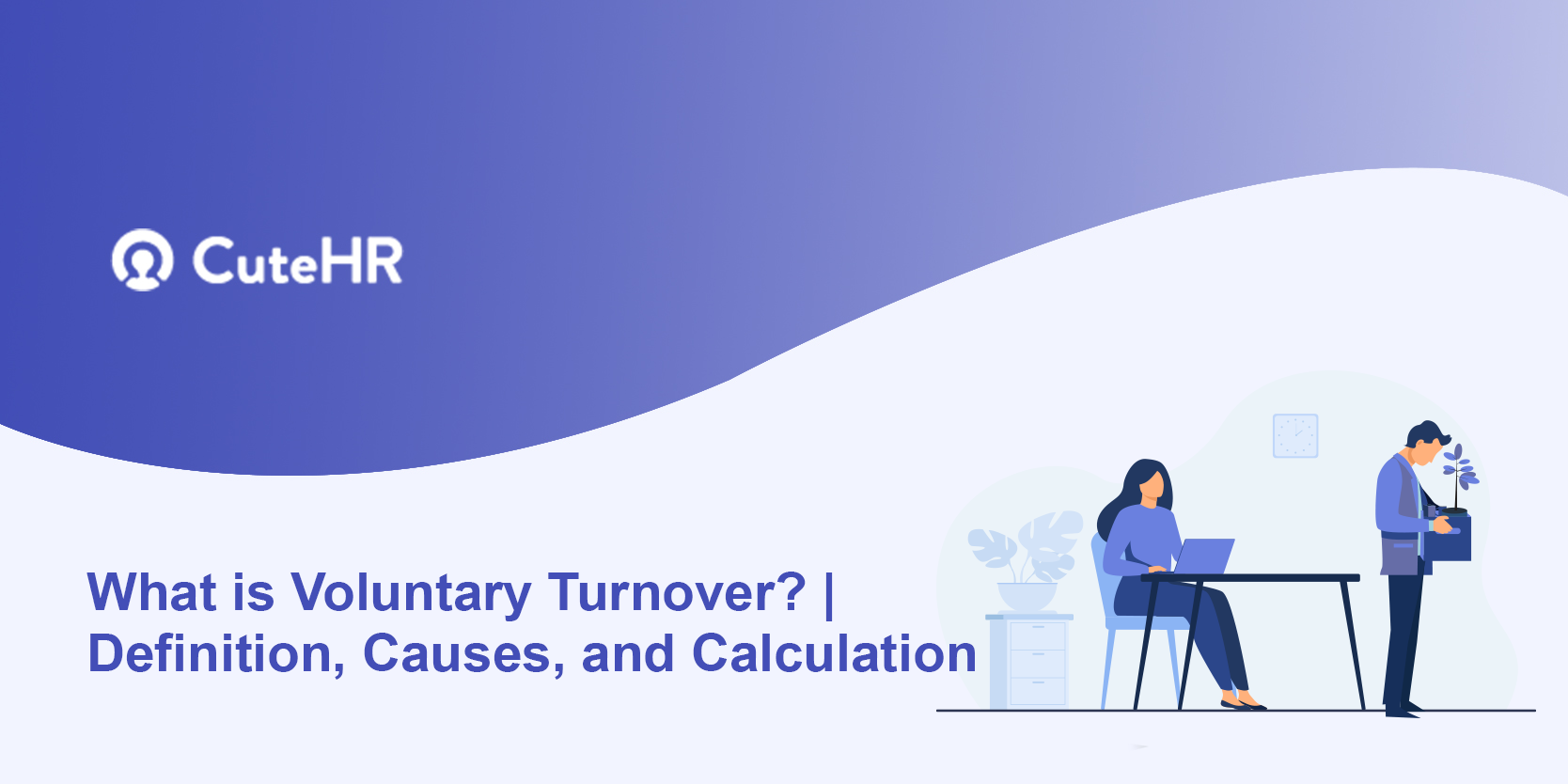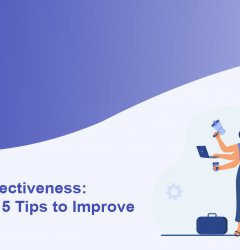13 May

Did you know? According to an ADP Research Institute research done in 2015-2016, the majority of sectors fell within the voluntary turnover 60-70 % range. Voluntary turnover is far more difficult to forecast because it is the consequence of an employee’s decision.
Voluntary turnover is expected when employees seek new opportunities or quit because they are disappointed with their existing position for a variety of reasons. However, it is still a costly exercise.
Consider the expenses of relocating, advertising a new post, the costs of having an empty role, recruitment costs, onboarding, and training of the new employee – you can see why it’s critical to grasp what voluntary turnover entails.
Table of Contents
What is Voluntary Turnover?
Voluntary turnover is defined as the number of employees who leave or are asked to leave a company and are replaced by new employees.
Voluntary turnover is often measured on an annual basis. It makes no difference whether the individuals quit or were fired; their absence reduces an organization’s total output.
According to the United States Bureau of Statistics, the annual turnover rate in the United States is between 12% and 15%.
This tendency may have a negative influence, but it isn’t always all that awful because when some employees leave, other ones come in. However, the rate at which the task is completed is influenced to some extent.
How can you assess the Voluntary Turnover Rate in your Company?
You may gain a better understanding of your organization’s voluntary turnover by examining the three key aspects listed below:
Who is leaving?
Regardless of the industry average, firms must know which individuals are departing. Only once you know, that will you be able to take the required steps, whether retention or letting them go. An analysis must be performed to determine if high achievers or low performers are departing. You may then take corrective action, as it may have an impact on employee retention, staff engagement, workforce productivity, and so on.
When are they going to leave?
Understanding voluntary turnover requires an understanding of when employees leave. If staff quit within a few weeks of starting, you may need to reconsider your recruitment techniques, job descriptions, and so on. If long-term employees are departing, it might be due to poor engagement, a lack of a clear career path, a lack of outstanding employee perks, and so on. Knowing these things can help you discover and improve your people processes.
Why are they quitting the company?
Employees leave for a variety of reasons, including employee processes, management style, supervisors, a lack of a feedback mechanism, and so on. You must do exit interviews to understand why they are leaving, what could be holding them back, and so on. Organizations cannot resolve all issues immediately, but they may begin with a few. Following that, the turnover rate will reveal what is and is not working.
How to Calculate Voluntary Turnover Rate?
- Determine the number of employees who left the company willingly in the previous year. Assume 25 employees departed the nation of their own volition.
- Determine the average number of employees employed by the company in the preceding 12 months. Assume, for example, if the company had 1,000 employees on average.
- Divide the number of employees who departed willingly by the average number of employees. Using the same example, 25/1000 equals 2.5 percent. This number shows the company’s voluntary turnover rate.
Main Causes of Voluntary Turnover
Toxic culture
Poor cultural fit is one of the most common, though sometimes misunderstood, causes of voluntary turnover. No, I don’t mean an individual who does not fit into the workplace culture; I mean a culture that does not fit its people. In other words, a business culture that undermines morale scares away fresh talent and purposefully pushes away its finest employees.
Retention rates will suffer if a company shows some of the tell-tale indicators of a poisonous culture. That organization may have the greatest people for the job, but those individuals will go as soon as they associate their rising stress levels, deteriorating physical and mental health, and diminishing motivation with the poisonous culture.
Lack of direction or meaning
People want their job to have relevance or to have some purpose. Working with the same goal may boost motivation and performance, as well as produce more cohesive teams.
This does not have to imply preserving the globe or promoting world peace. It can be as basic as having a similar vision or working together to achieve a common objective. Nine out of ten people are prepared to give up at least some of their present earnings to perform more important employment.
Unfortunately, it may be difficult to discover a feeling of meaning or purpose at some firms, which might lead to employees looking for work elsewhere.
It might be due to the nature of the work itself, or it could be that certain organizations are simply inept at cultivating a culture of meaningful work. In either case, something needs to change.
Work overload
Too much work, and therefore too much stress, is a primary reason for an employee’s choice to quit your firm and seek employment elsewhere. Unfortunately, overwork is the rule rather than the exception. According to studies, 53% of American employees are overworked and exhausted.
Overworked employees are more prone to disease, excessive stress, absenteeism, and, in certain situations, burnout and despair. Working more than 55 hours a week is severely harmful to your health in a variety of ways.
As if that weren’t enough, overworked staff are bad for your company’s financial line. However, the bottom line of your company is likely the last thing on the mind of an overworked, sad, burned-out employee as they peruse fresh job advertisements.
The boredom
A lack of difficult or interesting work, on the other hand, is a primary driver of voluntary turnover. To put it another way, ennui.
Employees get dissatisfied with their jobs for a variety of reasons. Boredom might develop if they believe their talents are underutilized or their employment lacks significance.
A mismatch between their passions and the sort of job they do or the organization for which they work might also be problematic. Those who are bored may be more anxious than overworked employees. It’s no surprise that boredom might push people to seek other employment.
A bad boss
People don’t leave their jobs; they leave their bosses. I’ve included this since a lousy boss is one of the top reasons for voluntary turnover. If your company is experiencing a brain drain, the most likely cause is inept, incompetent, or just malicious management.
Employees who do not trust their bosses are more likely to leave their employment, according to studies.
How to Reduce Voluntary Turnover?
It’s impossible to avoid turnover! However, as a company, you can certainly lower it. The following actions can be taken to prevent voluntary turnover:
Compensation should be competitive
Conduct some research on your compensation packages, examine them, and make them more competitive. Allow your HR staff to conduct research on the top packages in the market and develop something comparable for your firm.
Recognize and promote outstanding performers
Inquire about managers’/teams’ monthly/quarterly accomplishments. Recognize and reward your top performers. There is no greater delight than a job well done and appreciated in return. It is one of the least expensive methods of enhancing employee happiness.
Meet the training requirements of workers
Supervisors and managers play an important role in the company since they are the employees’ initial point of contact. If you are in higher management, make certain that your supervisors/managers have access to the finest and most essential training alternatives.
Employee incentives should be provided
The nature and expectations of employee benefits have developed in tandem with the changing nature of the workforce and industry. Employee perks such as student debt management, dental care coverage, and so on contribute significantly to employee satisfaction. Benefits like this influence their decision to stay.
Create and communicate a professional path
At the moment of employee onboarding, outline a clear professional advancement path. Discuss this with staff on a yearly basis. Provide opportunities for questions at meetings. Encourage them to speak to their managers or immediate supervisors if they are not comfortable speaking directly to management.
Find the best prospects
Train your hiring team to recognize the characteristics of a promising prospect; mastering the craft will take years of practice. Make the interview process as thorough as possible, and hire the proper personnel. This involves ensuring that the applicant completely matches the profile, mixes with the organization’s culture, and more.
The Cost of Voluntary Turnover
While voluntary turnover (workers leaving a company on their initiative) is common, all voluntary turnover is costly to an enterprise. Turnover costs can vary from 93 to 200 percent of an outgoing employee’s compensation, according to a recent Training & Development article, Warning Signs of Turnover Waiting to Happen.
The expenses of replacing individuals who leave the firm include advertising, relocation, onboarding, training, and staff time spent finding and choosing new personnel. This excludes the significant expenses of lost productivity and other indirect administration.
Given these measures, it makes logical for organizational leaders to decrease any employee turnover costs (voluntary or otherwise)–especially when this turnover implies losing superstar talent to other organizations.
Voluntary Turnover vs. Involuntary Turnover
There are two sorts of employee turnover, regardless of business type: voluntary turnover and involuntary. However, within each of those categories, there are different reasons why a firm could experience staff turnover. While the phrase “turnover” has a negative connotation at times, not all turnover is undesirable.
For example, when a poor performer is fired and replaced by someone who is driven and succeeds at their work, production can skyrocket. This new employee might provide financial rewards as well as a boost to team spirit.
Is Voluntary Turnover a Bad Thing?
Voluntary turnover is not necessarily bad. Why? Because it may provide an opportunity for new talent, new ideas, and assessments of what is most vital for a firm at any particular time. However, large voluntary turnover rates are frequently costly, unexpected, and disruptive.
Employers can typically consider two forms of voluntary turnover: functional voluntary turnover and dysfunctional voluntary turnover.
Poor performers who depart an organization are characterized by functional turnover. Functional turnover occurs when an employee, for example, is consistently late or regularly fails to fulfill their performance goals and departs the business.
Employers, on the other hand, should strive to avoid dysfunctional turnover. It occurs when top performers depart a company.
An excellent employee leaving for another firm because they received a higher remuneration package is one example of this.
Job Performance and Voluntary Turnover
A single firm’s 5,143 exempt workers were studied for the association between job performance and voluntary turnover because turnover was higher among low and high achievers than among average performers. Two putative curvilinearity modifiers were investigated in an attempt to explain inconsistent results in the performance-turnover literature.
Low wage increases and high promotions, as expected, resulted in a more prominent curvilinear performance-turnover connection. Notably, the impacts of other wage increases on turnover were highest for top achievers, with high salary growth predicting relatively low turnover for these individuals and low salary growth indicating significantly high turnover.
Furthermore, after wage increase was accounted for, promotions predicted turnover favorably, with poor performer turnover being the most substantially influenced.
How Can Turnover Be Positive for Your Company?
Improves Talent Potential
Voluntary turnover can sometimes be a sign of an organization’s progress toward success. There is a give and take when a company promotes continuous growth. Some personnel will rise to the challenge of rapid development and continue to fit the culture, while others will experience failures, a disconnect with the plan, or a desire to expand on a new path.
In all of these cases, it is preferable to let the person go rather than forcing them to conform to culture and vision that they would not typically accept.
An employee who does not believe in the business strategy, culture, or mission, no matter how talented, will not be as successful as a more aligned individual.
Without turnover, there is no room to hire, retain, and engage additional A Players.
Incentivizes Productivity and Avoids Complacent Work
When an employee quits, a position must be replaced. In some circumstances, your company will be able to swiftly find, train, and hire new employees. Those higher-level roles can be more difficult to replace and have a more negative impact. However, at those moments of shuffling, hitherto unknown A Players emerge. First and foremost, the position may provide a chance for remaining personnel who are required to demonstrate their expertise in the function.
Similarly, staff productivity is being evaluated. Employee turnover, whether regular or significant, pushes management to evaluate the remaining team. Underperformers appear alongside A Players.
Cracks are visible
When a high-performing person quits, a “systems test” is performed. How effectively are the company’s systems and workflows integrated? The flaws in these systems or procedures will become apparent shortly.
Because the person with the most information has departed, you have the chance to investigate the “cracks.” Concentrate on the issues and strengthen the procedure so that no “cracks” occur the next time someone leaves.
Having the individual who knows everything about the work develop a handbook can help the next person in that position succeed. This allows your firm to honor the contributions this person made while they were there.
Your duty as a leader is to prepare individuals to excel in their vocations and industries. Even though they are departing, the job they accomplished while at your organization is important, and it is appropriate to acknowledge that. You may run into them again in the professional world, so making a favorable impression on their career may benefit you.
Creating talent success
If a large portion of your organization’s turnover consists of high performers, you’ll want to take fast action to retain the appropriate workers.
If, on the other hand, you routinely see B or C players leaving on their own, it might be an indication that your performance-driven culture or pay plan is achieving its intended goal of maintaining and engaging the best of the best. Parting ways with poor performance or even a middle-of-the-road employee can be beneficial, but only if they are replaced with A Players.
Those new employees should be willing to question the status quo, bring ideas from past companies, or just have a new perspective on a program or plan that hasn’t been updated in a long time. Whatever drives the shift, the business can capitalize and, as a result, compete more effectively in their sector and market.
Wrapping It Up
Understanding your organization’s voluntary turnover allows you to establish methods to retain your employees on board for longer periods and to build an engaged, motivated staff.
The worst reaction to voluntary turnover is to believe that “there is nothing we can do.” The HR department can always do something – and a specialized approach to understanding each employee’s intrinsic and extrinsic motivators is required.
Frequently Asked Questions (FAQs)
What is the rate of voluntary turnover in the workforce?
As an example, suppose a company has 500 employees at the start of the year. Throughout the year, 75 workers depart willingly. Employee turnover would be calculated as 75 / 500 = 0.15, or 15%. Voluntary turnover can also be calculated as a proportion of total turnover.
Is voluntary turnover beneficial to an organization?
When low-performing individuals leave an organization, functional turnover happens, which can prevent your business from having to make difficult decisions and, in many cases, boost productivity levels.












Himani